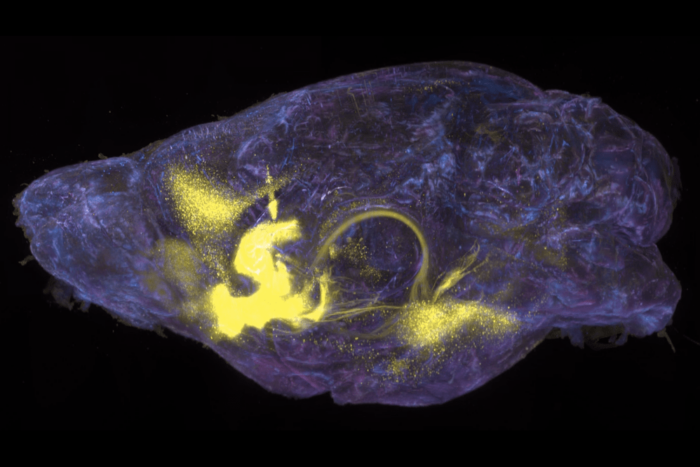Nobel Prize honors Rockefeller University scientist Roderick MacKinnon for revealing process of electrical signaling in humans and other living organisms
Rockefeller University Professor Roderick MacKinnon, M.D., a biophysicist and X-ray crystallographer whose exquisitely detailed portraits of a class of proteins explain the generation of nerve impulses — the electrical activity that underlies all movement, sensation and thought — is honored this year with the Nobel Prize in Chemistry, the Nobel Foundation in Stockholm, Sweden announced today. MacKinnon, who also is an investigator at the Howard Hughes Medical Institute, shares the prize with Peter Agre, M.D., at Johns Hopkins University School of Medicine.
The class of proteins, called ion channels, are tiny pores that stud the surface of all of our cells. These channels allow the passage of potassium, calcium, sodium and chloride molecules called ions. Rapid-fire opening and closing of these channels releases ions, moving electrical impulses from the brain in a wave to their destination in the body.
“Roderick MacKinnon’s successful exploitation of crystallography signals the dawning of a new era in the study of ion channels and the diseases associated with them,” says Rockefeller University President Paul Nurse, Ph.D., a Nobel laureate in Physiology or Medicine. “MacKinnon’s total dedication led to the spectacular achievement of the first fourhigh-resolution structures of ion- selective channels. This is a notable advance.”
Nurse adds, “MacKinnon combines mathematical, biophysical and molecular genetics tools to examine how ion channels, in particular, potassium ion channels, are built and how they function. His discoveries are of astonishing clarity and significance.”
Inherited and acquired defects of ion channels interfere with proper electrical signaling and can be fatal. The prognosis for cystic fibrosis, heart arrhythmias and other inherited and acquired electrical signaling diseases likely will improve in coming years as MacKinnon’s discoveries help doctors learn to remedy or prevent them.
Starting in 1998, after 10 years studying the biophysics of ion channels, MacKinnon published a series of four structural solutions — high-resolution molecular-level “snapshots” — of ion channels that literally showed the scientific community how electrical signaling occurs.
“We now can see that nature came up with a method for moving a signal that is elegant in its simplicity,” says MacKinnon.
MacKinnon, who is the John D. Rockefeller Jr. Professor and head of the Laboratory of Molecular Neurobiology and Biophysics, is a member of the Pels Family Center for Biochemistry and Structural Biology and the F.M. Kirby Center for Sensory Neuroscience.
MacKinnon is the 23rd scientist associated with Rockefeller University to be honored with the Nobel Prize. In the last five years, two other Rockefeller scientists — Paul Greengard, Ph.D. (2000) and Günter Blobel, M.D., PhD. (1999) — have received the Nobel for medicine. Nurse received his prize while he was director-general of the Imperial Cancer Research Fund in London.
In addition to MacKinnon, Nurse, Greengard and Blobel, four other Nobel Prize winners are current members of the Rockefeller faculty: Christian de Duve, M.D. (1974, Medicine), Torsten Wiesel, M.D. (1981, Medicine), Joshua Lederberg, Ph.D. (1958, Medicine) and Bruce Merrifield, Ph.D. (1984, Chemistry).
“A dream come true for biophysicists”
The transfer of potassium ions across cell membranes has long been understood as an essential activity for many life-sustaining functions. But until MacKinnon, in 1998, captured the potassium channel’s three-dimensional structural image, scientists could only guess at what the specialized protein looked like. The structure revealed a pyramid-shaped pore comprising four parts, like staves of a barrel.
News of the KcsA potassium channel structure (of the bacterium Streptomyces lividans) was lauded by one scientist as “a dream come true for biophysicists.” Since the shape of a protein corresponds with its function, seeing the ion channel protein provided a glimpse at the means by which ions, negatively or positively charged molecules, move across the cell wall via the proteins. Science magazine, which published the potassium structure publication as a cover story, deemed it one of its 10 “Breakthroughs of the Year.” MacKinnon modestly called his research “as basic as it gets,” but many scientists strongly praised his work. Largely as a result of this potassium channel accomplishment, MacKinnon was awarded the 1999 Albert Lasker Award for Basic Medical Research. His co-recipients of that year’s Lasker, Bertil Hille (a Rockefeller alumnus) and Clay Armstrong, are the statesmen of ion channel research whose earlier contributions in understanding the qualities of the proteins marked the beginning of modern neurophysiology, setting the stage for MacKinnon’s debut in the field in the late 1980s.
Closing the loop
Five years later, MacKinnon has improved the dream come true by revealing to the scientific community not only the basic structure of the potassium ion channel, but also the chemical-and voltage-dependent mechanisms that control its opening and closing, to allow potassium ions to move out of a cell.
The full range of activity of the latter of the three potassium ion channels — the voltage-dependent channel — has been a puzzle for over 50 years, since scientists Alan Hodgkin, Andrew Huxley and Bernard Katz proposed a theory called “the action potential.” The action potential explained how a nerve signal formed and moved throughout the body.
This theory, based on two mathematical equations, explained how cells are involved with moving a nerve signal along: permeability (which we now know is the open or closed positions of ion channels studding a cell’s outer membrane) impacts the positive or negative charge value of a cell’s membrane and creates an environment conducive to moving a signal along a cell’s surface.
The three scientists working in the 1950s suggested a feedback loop relating permeability and voltage: one condition determines the next, which in turn, creates the first condition all over again.
Experimental scientists in the meantime have long understood how permeability sets the voltage of a cell membrane, but until Rod MacKinnon came along, no one ever understood how the voltage of a cell’s membrane could determine whether ion channels were opened or closed.
Hodgkin and Huxley were awarded a Nobel Prize for their action potential theory in 1963. Today, 40 years later, MacKinnon shares the Nobel Prize and has wowed biologists by discovering how the electrical charge of a cell’s membrane determines the open or closed position of an ion channel. Our understanding of Hodgkin and Huxley’s feedback loop is finally complete, thanks to Rod MacKinnon.
Finding the “inner beauty”
Other scientists steeped in molecular genetics have collaborated with an outstanding X-ray crystallographer to solve protein structures. MacKinnon, exhibiting his typical independence and rigor, instead became that crystallographer.
Ion channels, also called integral, or transmembrane, proteins, defy crystallographic visualization. The problem is that these proteins naturally stud the walls of cells and because of their positioning and the role they play, they are hydrophobic or water hating. To form crystals, the proteins must be isolated in the lab and many copies — freed from their natural context — must be produced in a “water-loving” manner. The other problem is that getting a protein to crystallize doesn’t guarantee that it will diffract light properly.
Yufen Zhou, Ph.D., a postdoctoral fellow in MacKinnon’s laboratory, says, “So many crystals look beautiful but they don’t diffract well. We always say it’s an ‘inner beauty’ that makes a protein diffract well. If you’re a crystal, you have to have inner beauty. And only X-ray diffraction can tell if your crystal has inner beauty.”
Crystals are important because by definition they contain a repeating pattern of a molecule within them. The X-ray diffraction from one molecule would not be significant enough to study confidently.
After carefully cultivating ion channel proteins that crystallize, MacKinnon and his research team record a diffraction pattern that can be interpreted mathematically by a computer. This turns the computer into a virtual lens, so that the three-dimensional structure of a molecule is visible on a monitor.
Keeping K+ comfortable
In 2001, MacKinnon and his team showed for the first time a feature, called a “selectivity filter,” that allows the correct ions – sodium, potassium, calcium or chloride — to pass through a channel of a protein. Based again on the potassium channel and shown in another lucid crystallographic image, the selectivity filter was a breathtaking scientific discovery.
“We knew the overall structure would be similar in channels that conduct potassium, sodium and calcium ions, all positively charged, but the chemistry in the selectivity filter is unique in each specific case,” says MacKinnon.
The Rockefeller scientists learned that this chemistry provides a means of keeping an ion “comfortable” by creating a substitute for potassium’s “water coat” or hydration shell while it moves through the selectivity filter.
Gatekeepers of the cell
Ion channels, embedded in the cell wall, perform the dual functions of gateway and gatekeeper. Also in 2001, MacKinnon and his colleagues solved a puzzle involving another area of the ion channel, the inactivation gate. Using techniques to produce precise mutations in the channels, coupled with X-ray crystallography, the researchers deduced that one of four long tails at the end of the channel can slide into the channel’s pore and shut it down.
This understanding of how the channels slam shut explains how channels regulate the frequency of nerve signal firing and other critical bodily functions. The research greatly refines our understanding of how potassium ion channels manage to close milliseconds after opening and, like the selectivity filter discovery, offers insights that will aid in designing drugs that control the channels more precisely.
Nature makes exceptions
What does nature do when it needs to move a negatively charged ion? It creates an exception, of course. In early 2002, MacKinnon and his research team revealed the structure of the ClC chloride channel, whose shape is very different from the potassium ion channel.
This ion channel protein, which permits the movement of a different, negatively charged, ion, is shaped like an hourglass. The shape helps overcome the energy barrier between the outside of a cell and its internal environment, and contrasts with the potassium channel’s pyramid shape.
Setting himself apart
A native of Massachusetts born in 1956, MacKinnon was drawn to science from childhood by his love of solving puzzles and his fascination with the natural world. He received a B.A. degree in biochemistry from Brandeis University in 1978 and an M.D. from Tufts University in 1982. Choosing to pursue a career in basic research, he returned to Brandeis in 1986 for postdoctoral studies. In the laboratory of Christopher Miller, Ph.D., his undergraduate mentor, he began working on biophysical aspects of ion channel function — focusing on the protein selective for potassium ions — and continued these studies at Harvard Medical School, whose faculty he joined in 1989.
After advancing to full professor at Harvard Medical School, MacKinnon joined The Rockefeller University in 1996 as professor and head of the Laboratory of Molecular Neurobiology and Biophysics. In 1997, he was appointed an investigator of the Howard Hughes Medical Institute. He was elected to membership in the U.S. National Academy of Sciences in 2000.
For tackling head-on the relationship between ion channel structure and function, MacKinnon’s achievements have been richly rewarded. The scientific community has recognized his contributions by bestowing upon him some of its highest honors, including after the 1999 Lasker Award, the 2000 Rosenstiel Award and the 2001 Gairdner Award.
“My belief is that if you do good science, science will take care of you,” MacKinnon says. “If you tackle a problem and keep working on it, eventually you will find some kind of outcome.”
And for so boldly following the beacon lit by Alan Hodgkin, Andrew Huxley and Bernard Katz, the three scientists who explained the generation and propagation of the nerve impulse, MacKinnon was honored with the inaugural Hodgkin-Huxley-Katz Prize by the British Physiological Society in 2000.
MacKinnon’s research has been supported in part by the federal government’s National Institutes of Health.
News Releases by this Head of Laboratory
MacKinnon lab’s newest picture tells action potential story


